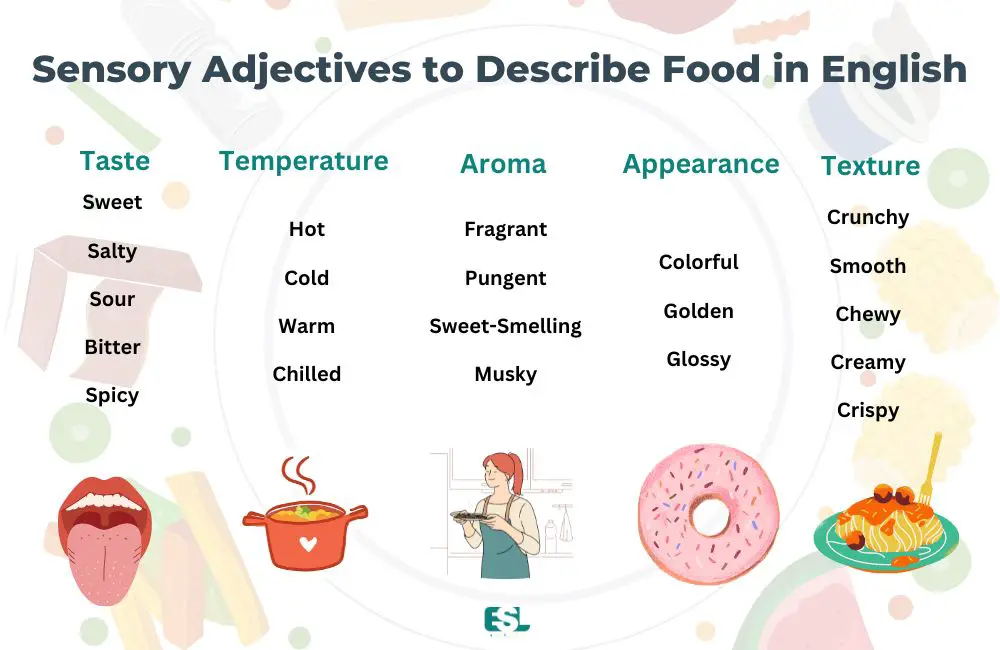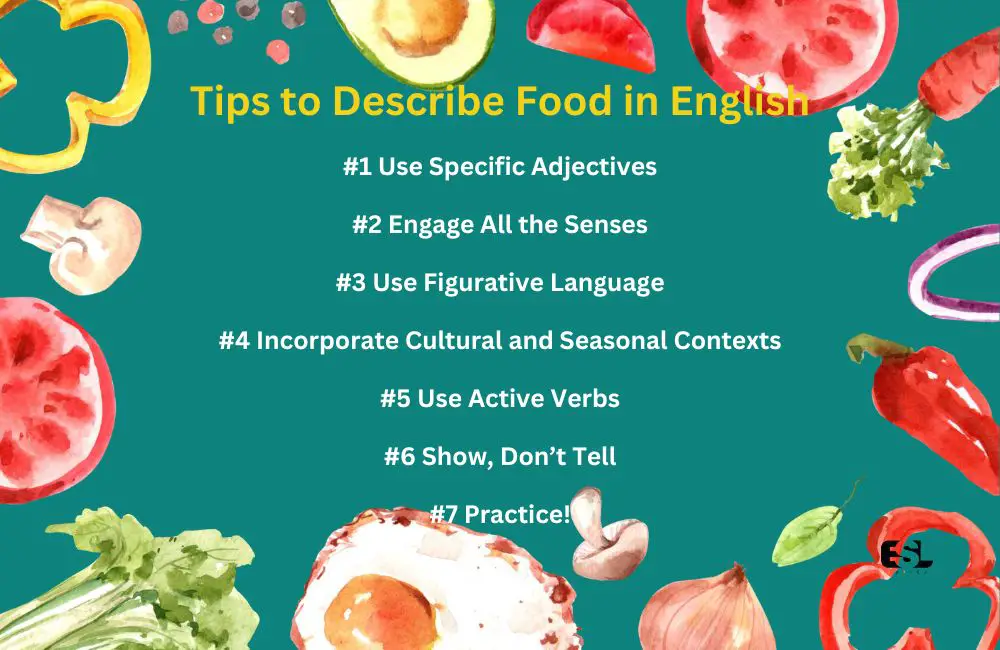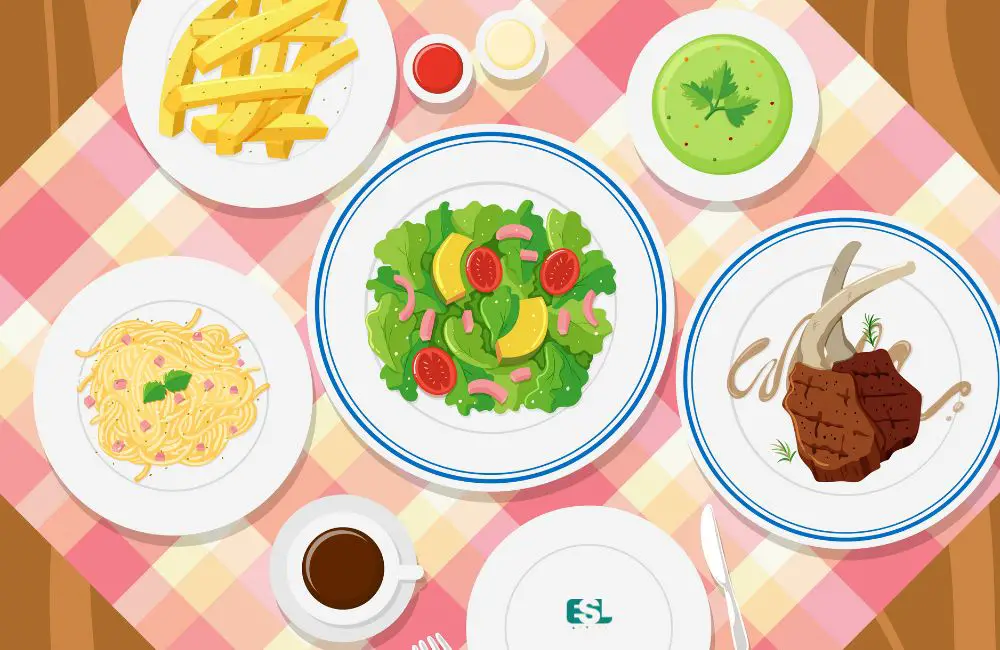Food plays a vital role in our lives. It not only nourishes us but also creates a basis for us to connect with different cultures, celebrations, and traditions. However, describing food in English can be a challenge, especially for non-native speakers. This article will provide a complete guide to help you describe food in English, complete with lists of expressions and useful tips.
Describing food in English involves using sensory adjectives to express taste (sweet, sour), texture (smooth, crunchy), smell (fragrant, musky), and temperature (hot, chilled). For instance, “The fragrant curry was a hot, spicy delight with a smooth texture.”
Do you know that blueberries can boost brain longevity, kiwis are potent fighters against cancer and heart disease, and pears can help stave off fibroid tumors? If interested to know, check Food As Medicine: How to Use Diet, Vitamins, Juices, and Herbs for a Healthier, Happier, and Longer Life (Amazon Link) by health guru Dr. Dharma Singh Khalsa. The book combines spiritual advice and integrative medicine to provide healthful recipes and nutrition plans targeting common and chronic illnesses for a longer, healthier, natural life.
There’s more to learn about the nuances of describing food, such as how to evoke the right imagery and emotions, apply cultural and seasonal vocabulary, and effectively use similes and metaphors. Keep reading to delve deeper into the techniques and expand your food vocabulary.
Table of Contents
- Use Sensory Adjectives to Describe Food in English
- Use Similes and Metaphors to Describe Food in English
- Use Cultural and Seasonal Food Descriptions
- Tips to Describe Food in English
- Sample Conversation: Describing Food in English
- In Conclusion
- 10 Frequently Asked Questions Related to Describing Food in English
Use Sensory Adjectives to Describe Food in English
Food’s sensory experience encompasses all we perceive when we eat, including what we taste, smell, feel, and even hear. This multi-sensory experience is complex and dynamic, shaped by the interplay of many factors, including the food’s ingredients, how it’s cooked, and the context in which it’s eaten.

Understanding sensory adjectives allows us to articulate and convey these experiences to others. We can describe food’s taste, texture, smell, and sound, providing a rich, detailed picture of our food experiences. In this section, we will explore sensory adjectives related to taste, texture, and aroma, among others, and provide examples of how to use these adjectives in sentences.
Taste Adjectives
When it comes to food, the taste is paramount. Our tongues can detect five basic tastes – sweet, salty, sour, bitter, and umami (savory). Each of these tastes evokes a different sensory experience and is associated with specific types of food. By using taste adjectives effectively, we can vividly describe these experiences and share our food encounters with others.
1. Sweet
Sweetness, often associated with sugary foods, is a taste most people enjoy. It’s not just about desserts; many foods have an inherent sweetness that balances other flavors.
- The caramelized onions added a delightful sweetness to the savory tart.
- She enjoyed the sweet taste of the ripe mango.
- The sweet maple syrup made the pancakes irresistible.
- The sweet creaminess of the butternut squash soup was comforting.
- The candy was too sweet for my liking.
- The sweet aroma of the cinnamon rolls filled the bakery.
- The dessert had a sweet aftertaste that lingered in my mouth.
2. Salty
Salty is a taste that can enhance other flavors. However, too much salt can be overpowering.
- The salty flavor of the pretzels was a perfect contrast to the sweet mustard dip.
- I could taste the salty sea on my lips after eating the oysters.
- The dish was overly salty, making it hard to discern the other flavors.
- The salty fries were perfect with the sweet ketchup.
- I craved a salty snack after my workout.
- The cheese had a sharp and salty taste, adding depth to the pizza.
- The broth was clear with a subtle salty taste.
3. Sour
Sourness often contributes to the tangy taste of food. It’s a flavor profile that adds a kick to food and can vary from a light tartness to a strong sour taste.
- The sour taste of the lemon made my lips pucker.
- The pickles were sour, providing a delightful contrast to the rich, savory burger.
- The sourdough bread had a nice, sour tang that complemented the creamy cheese.
- She sipped the sour beer, its tartness making her tastebuds tingle.
- The sour candy made my eyes water.
- The dressing was a refreshing mix of sour lime and spicy chili.
- The grapes were a little sour, still needing time to ripen.
4. Bitter
Bitterness is a complex taste, often associated with foods like dark chocolate, coffee, and some vegetables. It can balance sweetness or add depth to a dish.
- The bitter taste of the coffee was offset by the creamy sweetness of the whipped cream.
- The kale had a bitter edge that was tamed by the tangy dressing.
- He enjoyed the bitter dark chocolate that melted slowly in his mouth.
- The grapefruit had a bitter aftertaste.
- The beer was bitter with a hoppy finish.
- The medicinal herb had a bitter taste that made it hard to swallow.
- The walnuts added a bitter crunch to the sweet salad.
5. Spicy
Spiciness is not a taste but a sensation. Foods with heat, like those with chili peppers, are often described as spicy.
- The spicy curry made my mouth tingle.
- She added extra jalapeños to her taco for a spicy kick.
- The spicy ginger added warmth to the tea.
- The salsa was too spicy for me to handle.
- The dish was subtly spicy, with a warmth that built up as you ate.
- The spicy chicken wings were a challenge to eat but delicious.
- The pepper added a spicy note to the tomato soup.
With these adjectives in your vocabulary, you are now equipped to describe the taste of food in more detail and nuancedly. So, the next time you have a memorable food experience, remember to use these adjectives to share it with others.
Texture Adjectives
The texture of food significantly contributes to our overall eating experience. Texture engages our sense of touch and hearing, and it can often be as important as taste in determining whether we enjoy a dish. Describing food’s texture can paint a more comprehensive picture of what it’s like to eat, adding depth to our descriptions. In this section, we’ll explore some commonly used adjectives for describing food texture and provide example sentences to illustrate their usage.
1. Crunchy
“Crunchy” describes firm food that makes a noise when you bite or break it. Crunchiness can be satisfying in many foods, from fresh fruits and vegetables to baked goods and snacks.
- The freshly baked bread had a crunchy crust that complemented its soft interior.
- She enjoyed the crunchy texture of the granola in her yogurt.
- The salad was made up of crunchy, fresh vegetables.
- The roasted almonds added a crunchy element to the smooth ice cream.
- He savored the crunchy fried chicken with its perfect golden crust.
- The cereal remained crunchy even after adding the milk.
- The crunchy biscuits were a great accompaniment to the creamy cheese.
- The sushi roll had crunchy tempura shrimp inside.
2. Smooth
“Smooth” is used to describe food without any lumps, bumps, or roughness. This term can be used to describe silky sauces, creamy soups, or even the texture of certain kinds of cheese and yogurt.
- The avocado spread was smooth and creamy.
- He savored the smooth, rich texture of the chocolate mousse.
- The hummus was perfectly smooth and garnished with olive oil.
- The custard had a smooth texture that contrasted with the crunchy caramel on top.
- The smoothie was so smooth and well-blended that it felt like drinking liquid fruit.
- The peanut butter was incredibly smooth, with a richness that filled the mouth.
- The ice cream melted into a smooth, sweet pool in the bowl.
- The tofu had a smooth texture, absorbing the flavors of the soup.
3. Chewy
“Chewy” describes food that needs to be chewed a lot before it can be swallowed. Bread, certain types of meat, or sweets like caramel and gummy bears often have a chewy texture.
- The steak was chewy, indicating it was slightly overcooked.
- The fresh bagels were satisfyingly chewy.
- The dried fruit in the granola bar added a chewy texture.
- The chewy caramel stuck to my teeth.
- The pizza crust was chewy and thick, just how I like it.
- The gummy candies were chewy and sweet, a perfect treat.
- The chewy cookies were filled with chocolate chips.
- The homemade pasta was perfectly al dente, with a slightly chewy texture.
4. Creamy
“Creamy” describes food that has a thick, smooth texture. It can refer to dairy products like cheese, ice cream, and custard, but it can also describe the texture of certain sauces or pureed foods.
- The pasta sauce was creamy and flavorful.
- She loved the creamy consistency of the yogurt.
- The risotto was creamy, with a hint of parmesan.
- The creamy cheesecake melted in my mouth.
- The butternut squash soup had a velvety, creamy texture.
- The mashed potatoes were perfectly creamy, with a hint of garlic.
- The buttercream frosting was so creamy and sweet.
- The creamy dressing complemented the crisp salad perfectly.
5. Crispy
“Crispy” describes slightly hard food that makes a sharp noise when broken or bitten into. It can be used to describe a wide range of foods, from roasted vegetables and toast to fried foods and certain types of candy.
- The potatoes were crispy on the outside and soft on the inside.
- He bit into the crispy bacon, enjoying its smoky flavor.
- The chicken skin was perfectly crispy.
- The crispy toast was slathered with butter and jam.
- The fried onions added a crispy topping to the green bean casserole.
- The sugar coating on the doughnut was crispy and sweet.
- The apple was crispy and juicy, a perfect afternoon snack.
- The roasted chickpeas were a crispy, healthy snack.
Aroma Adjectives
Just as we use our sense of taste and touch to experience food, our sense of smell, or olfaction, plays a significant role in how we perceive and enjoy what we eat and drink. The aroma of a dish can set expectations, evoke memories, and even influence our perceived taste. This section explores various adjectives related to the aroma that can add another layer of depth to your food descriptions.
1. Fragrant
“Fragrant” is an adjective often used to describe a sweet or pleasant smell that’s usually quite strong. This term is particularly useful when describing foods like herbs, spices, certain fruits, and baked goods.
- The kitchen was filled with the fragrant aroma of baking bread.
- The fragrant jasmine rice complemented the spicy curry.
- She picked the most fragrant strawberries from the market.
- The tea was fragrant with notes of mint and honey.
- The sauce was fragrant with garlic and fresh basil.
- He woke up to the fragrant smell of coffee brewing.
- The cookies were fragrant with vanilla and cinnamon.
- The soup was fragrant with a bouquet of fresh herbs.
2. Pungent
“Pungent” is used to describe a smell that’s strong and sharp, sometimes to the point of being unpleasant. It’s often used for strong-smelling cheeses, spices, garlic, and onions.
- The pungent aroma of the garlic wafted through the kitchen.
- He enjoyed the pungent, earthy smell of the truffle oil.
- The blue cheese was pungent and tangy.
- The curry was pungent with strong spices and chilies.
- The onion released a pungent smell as she chopped it.
- The fish sauce added a pungent, umami flavor to the dish.
- The cheese platter had several pungent varieties that paired well with the sweet fruit.
- The freshly ground coffee beans had a pungent, irresistible aroma.
3. Sweet-Smelling
“Sweet-smelling” describes a pleasing aroma, often associated with desserts, fruits, or sweet spices.
- The sweet-smelling caramelized onions added a depth of flavor to the dish.
- Walking into the bakery, we were greeted by a sweet-smelling cloud of freshly baked bread.
- Her kitchen always had a sweet-smelling aroma of baked goods.
- The sweet-smelling aroma of the apple pie filled the room.
- She enjoyed the sweet-smelling fragrance of vanilla from the custard.
- He woke up to the sweet-smelling scent of pancakes.
- The sweet-smelling strawberries made the salad even more appealing.
- The sweet-smelling cinnamon in the hot chocolate made it even more comforting.
4. Musky
“Musky” is used to describe a heavy, slightly sweet smell, often used for aged cheese, wine, or certain kinds of fish.
- The musky smell of the blue cheese added a complex flavor to the dish.
- He detected the musky aroma of truffle oil in the pasta.
- The wine gave off a musky scent, indicating its maturity.
- The musky odor of the mushrooms was incredibly earthy and rich.
- The soup had a musky aroma from the variety of root vegetables used.
- The musky scent of the sautéed garlic added depth to the stir-fry.
- She savored the musky aroma of the freshly baked sourdough bread.
- The musky fragrance of the ripe durian fruit was overpowering.
Temperature Adjectives
Temperature is another important food aspect that can affect its taste and texture. Whether a dish is meant to be served hot, warm, cool, or cold can dramatically change its flavor profile and how we experience it. Let’s look at some adjectives that help describe the temperature of food.
1. Hot
The term “hot” is used to describe food served at a high temperature. This can refer to freshly cooked or heated dishes, or drinks like coffee or hot chocolate.
- The hot soup warmed me up instantly.
- She blew on the hot coffee before taking a cautious sip.
- The hot pasta was steaming and garnished with fresh basil.
- I burned my tongue on the hot sauce.
- The hot toast melted the butter instantly.
- He took the hot pan off the stove.
- She loved the hot porridge on cold winter mornings.
- The hot tea was soothing and aromatic.
2. Cold
“Cold” is used to describe food that is served at a low temperature. This can refer to dishes that are meant to be served chilled, like a salad or sushi, or drinks like iced tea or a smoothie.
- The cold beer was refreshing on the hot summer day.
- She bit into the cold, juicy watermelon.
- The cold ice cream was a treat on a warm day.
- He poured some cold milk into his coffee.
- The cold salad was crisp and refreshing.
- She enjoyed a cold smoothie after her workout.
- The sushi was cold and fresh.
- He took a sip of the cold, fizzy soda.
3. Warm
“Warm” describes food that is slightly hot, providing a comfortable warmth when eaten. It can be used to describe freshly baked goods, a mildly heated beverage, or a dish that has cooled down a little after being cooked.
- She sipped her warm tea, feeling the gentle heat spread through her body.
- The warm muffins, fresh from the oven, were a breakfast delight.
- He loved the warm toasted bread with a dollop of butter melting on top.
- The warm soup was comforting on a chilly day.
- She felt the warm cheese ooze out of the freshly grilled sandwich.
- He enjoyed the warm porridge in the morning, a perfect start to his day.
- The warm pasta sauce clung to the spaghetti, making it incredibly flavorful.
4. Chilled
“Chilled” describes food or drinks that are served cold, often having been refrigerated or iced. It’s used for desserts, cold beverages, or refreshing salads.
- On a hot day, the chilled lemonade was the perfect thirst quencher.
- The chilled soup, vibrant with summer vegetables, was refreshing.
- She enjoyed the chilled fruit salad, a healthy and cooling dessert.
- The chilled chocolate mousse was a delightful end to the meal.
- He relished the chilled beer on a lazy summer afternoon.
- The chilled wine brought out the subtle flavors of the cheese.
- She appreciated the chilled cucumber slices in her salad, adding a crisp and cool element.
- The chilled smoothie was a blend of fruits and yogurt, perfect for a quick snack.
Appearance Adjectives
Eating is not just a gustatory experience; it also involves our other senses, including our sight. Food’s visual aspect can be equally important as taste, aroma, and texture. We often hear the phrase, “We eat with our eyes first,” and there’s a great deal of truth to it. The way food looks can greatly influence our desire to eat it and our perception of how it will taste. Here, we’ll explore some adjectives that can help you describe the appearance of food.
1. Colorful
“Colorful” describes food that includes many different colors. It is often used to describe dishes that include various fruits, vegetables, or other ingredients with distinct colors.
- The salad was colorful, with red tomatoes, green lettuce, yellow bell peppers, and purple onions.
- The fruit salad was a colorful mix of strawberries, oranges, bananas, and blueberries.
- She decorated the cake with colorful frosting and sprinkles.
- The sushi roll was colorful, with pink tuna, orange salmon, and green avocado.
- The market stand was filled with colorful fruits and vegetables.
2. Golden
“Golden” describes food with a deep yellow color, often from being cooked or baked.
- The fries were a perfect golden brown.
- She sliced into the golden loaf of bread.
- The pancakes were golden and fluffy.
- He spread butter on the golden cornbread.
- The roast chicken had a golden, crispy skin.
3. Glossy
“Glossy” refers to food that has a shiny surface. It’s often used to describe glazes, icings, or certain types of sauces.
- The donuts were covered with a glossy chocolate glaze.
- The roast was topped with a glossy, savory gravy.
- The cake was finished with a glossy layer of ganache.
- The teriyaki chicken had a glossy, sweet, and salty glaze.
- The apples in the tart were glossy and caramelized.
Using these and similar adjectives can help your readers visualize the food you’re describing, adding to their understanding and appreciation of it. Remember, the goal is to engage as many of the reader’s senses as possible for a truly immersive description.
To learn some more adjectives to be able to use in various real life situations, you may try one of my favorite books 10,000 Useful Adjectives In English: Types, Degrees and Formation of Adjectives (Amazon Link).
Use Similes and Metaphors to Describe Food in English
When you’re writing about food, you want to bring your descriptions to life. One of the ways to do this is by using figurative language like similes and metaphors. These rhetorical devices can add a layer of complexity and vividness to your food descriptions that factual descriptions might not.
They can make your descriptions more engaging, entertaining, and memorable, as they allow you to convey not just the physical attributes of the food but also the emotional experience of tasting it. This section will guide you on how to use similes and metaphors effectively in your food descriptions.
Similes in Food Description
Similes are a type of figurative language that make comparisons using the words “like” or “as.” In food descriptions, similes can help your reader imagine the taste, texture, appearance, aroma, or even the temperature of the food by likening it to something else that they are familiar with.
- The cheesecake is smooth as silk.
- Her homemade cookies were sweet, like honey.
- The coffee was as bitter as a cold winter morning.
- The hot sauce was spicy, like a blazing fire.
- The freshly baked bread was as fragrant as a blooming garden.
- The wine was as sour as a green apple.
- The steak was as tender as a mother’s love.
- The chocolate was as rich as a queen’s jewels.
- The sushi was as fresh as a morning breeze.
- The soup was as hot as the sun.
- The roasted chicken was golden, like a summer sunset.
- The pasta was as chewy as rubber.
- The apple was as crisp as a fresh dollar bill.
- The pizza was as cheesy as a rom-com movie.
- The ice cream was cold as an icy wind.
Metaphors in Food Description
Metaphors, like similes, are a form of figurative language. However, instead of making a comparison using “like” or “as,” metaphors make a more direct comparison by stating that something is something else. In food descriptions, metaphors can make your descriptions more dramatic and impactful by equating the food to something else entirely.
- The cake was a symphony of flavors.
- The soup was a warm hug on a cold day.
- The steak was a ticket to carnivore heaven.
- Her pasta was a tangled web of deliciousness.
- The salad was a vibrant mosaic of fresh produce.
- The ice cream was a creamy cloud of sweetness.
- The cheese was a velvety treasure.
- The fresh fruit was nature’s candy.
- The wine was liquid gold.
- The coffee was black magic in a cup.
- The pizza was a disc of pure joy.
- The sandwich was a skyscraper of delectable ingredients.
- The sushi was an ocean journey in one bite.
- The tart was a circle of tangy delight.
- The soup was a comforting blanket of warmth.
Incorporating similes and metaphors into your food descriptions can elevate your writing, allowing you to express objective facts about the food and the subjective experience of tasting it. Remember, the best food descriptions are those that engage all the senses and evoke emotions, and similes and metaphors are powerful tools to help you achieve this.
Use Cultural and Seasonal Food Descriptions
Food is a vital part of our cultural and seasonal experiences. Different cultures around the world have unique dishes that embody their traditions, while each season brings its own bounty of produce and special dishes.
As such, when describing food, drawing upon cultural and seasonal contexts can be effective to make your descriptions more rich and engaging. This can give your readers a better sense of the food’s flavor profile and its cultural significance or its place in the rhythm of the seasons. This section explores how to incorporate cultural and seasonal descriptions into your food writing.
Cultural Descriptions
Food is an integral part of the culture. It’s tied to traditions, customs, and celebrations and often holds a lot of emotional significance. Here are some examples of how you can use cultural context to describe food.
- The pasta was a taste of Italy, with its rich tomato sauce, fresh basil, and al dente noodles.
- The sushi was an homage to Japan, with its delicate balance of flavors and beautiful presentation.
- The curry was a celebration of Indian spices, with its complex layers of heat, sweetness, tanginess, and fragrance.
- The tagine was a journey to Morocco, with its slow-cooked lamb, fragrant spices, and sweet dried fruits.
- The jerk chicken was a tribute to Jamaica, with its fiery spices, tangy citrus, and smoky grilled flavor.
- The croissant was a slice of Paris, with its buttery flakiness and golden hue.
- The churros were a sweet memory of Spain, with their sugary crunch and warm, doughy interior.
Seasonal Descriptions
The changing seasons bring a variety of fresh produce and dishes that embody those seasons. Here are some examples of how you can use seasonal context to describe food.
- The salad was a celebration of summer, with its juicy tomatoes, crisp cucumbers, and refreshing vinaigrette.
- The apple pie was an ode to autumn, with its warm spices, sweet apples, and buttery crust.
- The stew was a hug in a bowl for the winter, with its hearty ingredients, rich broth, and warming spices.
- The strawberry shortcake was a welcome to spring, with its sweet strawberries, light biscuit, and fluffy whipped cream.
- The roasted root vegetables were an autumnal medley with their earthy flavors and vibrant colors.
- The gazpacho was a cool escape from the summer heat, with its blend of refreshing vegetables.
- The hot chocolate was a winter comfort, with its rich chocolatey sweetness and comforting warmth.
Incorporating cultural and seasonal context into your food descriptions can make them more engaging, vivid, and relatable. It allows your readers to understand not just the taste, texture, aroma, and appearance of the food but also its cultural resonance or its connection to a particular time of year.
Are you looking for a book or a guide to help you learn and improve your English? You may try English Made Easy Volume One: A New ESL Approach: Learning English Through Pictures (Amazon Link). This book creatively uses pictures and text in tandem to revolutionize English language learning, making it easier to understand and more effective overall.
Tips to Describe Food in English
Writing about food in English can seem daunting, especially when trying to convey the experience of eating something delicious. How can words capture the sensations of taste, smell, texture, and appearance? But with some practice and a few handy tips, you can craft descriptions that allow your readers almost to taste the food. Here are seven tips for describing food in English.

#1 Use Specific Adjectives
Avoid generic adjectives like “good” or “tasty.” Instead, try to use more specific words that precisely convey the qualities of the food. For example, instead of saying, “The cake was good,” you might say, “The cake was moist and rich with a velvety chocolate frosting.”
#2 Engage All the Senses
When describing food, don’t just focus on the taste. Engage all the senses by describing the appearance, smell, texture, and even the sound of the food. For example, “The bread had a golden crust that crackled when broken, revealing a soft, warm interior that smelled of yeast and toasted grains.”
#3 Use Figurative Language
Similes, metaphors, and personification can add depth and creativity to your descriptions. They allow you to describe the food compared to other things or experiences, making your descriptions more engaging and vivid. For example, “The steak was a tender symphony of flavors, each bite a crescendo of savory satisfaction.”
#4 Incorporate Cultural and Seasonal Contexts
Food is often tied to a specific culture or season; you can use this to enrich your descriptions. Mentioning these contexts can give the reader a greater sense of the food’s place in a certain tradition or time of year. For example, “The pumpkin pie, spiced with cinnamon and nutmeg, was a sweet celebration of autumn.”
#5 Use Active Verbs
Active verbs can make your descriptions more dynamic and interesting. Instead of saying “The ice cream was on the cone,” you could say, “The ice cream perched on the cone, its edges slowly melting in the summer heat.”
#6 Show, Don’t Tell
Instead of simply telling the reader that the food is delicious, show them why it’s delicious. Describe the ingredients, the preparation, the flavors, and the textures that make it so enjoyable. For example, instead of saying, “The pasta was delicious,” you might say, “The pasta, coated in a creamy alfredo sauce and sprinkled with fresh parmesan, was a rich, comforting delight.”
#7 Practice!
Like any form of writing, practice makes perfect. The more you practice writing about food, the more comfortable you’ll become with using different descriptors and figurative language. Try describing the food you eat in your everyday life, whether it’s a simple sandwich or a gourmet meal.
With these tips, you should be well on your way to writing enticing and mouth-watering food descriptions in English!
Sample Conversation: Describing Food in English
Situation: Anna and Ben are at a new gourmet restaurant, trying out different dishes and sharing their opinions about the taste, texture, and presentation.
Anna: Wow, Ben, look at this dish! The presentation is so aesthetically pleasing. The colors are so vibrant.
Ben: I agree, Anna. The aroma is also quite enticing. It has a fragrant hint of rosemary and thyme.
Anna: The steak is succulent and tender. It’s cooked to a perfect medium-rare, just the way I like it.
Ben: And this sauce is creamy with a slight tanginess to it. It complements the steak beautifully.
Anna: The vegetables are crisp and fresh. They’ve got this earthy flavor that’s so natural and unprocessed.
Ben: I must say, the dessert was the highlight for me. The chocolate mousse was so rich and decadent with a velvety texture.
In Conclusion
learning how to describe food in English can be a delightful journey. It enhances your vocabulary and adds depth to your gastronomic experiences. By mastering the use of sensory, simile, metaphorical, cultural, and seasonal descriptions, you can paint a vivid picture of any dish and elevate your language skills. So, take your time to explore, experiment, and enjoy the art of describing food!
10 Frequently Asked Questions Related to Describing Food in English
1. What adjectives can be used to describe the taste of food?
Adjectives like salty, sweet, bitter, spicy, and sour are commonly used to describe the taste.
2. How can I describe the texture of food?
You can use terms like crunchy, smooth, chewy, gritty, and soft to describe the texture.
3. How can I talk about the spiciness of a dish?
You can say the dish is mild, medium, spicy, or extra spicy. Words like fiery and pungent can also describe very spicy dishes.
4. What words can describe the temperature of food?
Hot, warm, lukewarm, chilled, and cold are terms commonly used for temperature.
5. How can I describe food that’s cooked perfectly?
Terms like well-done, medium, medium-rare, and rare are often used, especially for meats.
6. How can I describe the freshness of food?
You can use adjectives like fresh, ripe, crisp, and juicy to indicate freshness.
7. What terms can describe unhealthy or overly rich foods?
Greasy, fatty, oily, heavy, and sugary are commonly used for such foods.
8. How can I describe a dish’s appearance?
Adjectives like colorful, appetizing, garnished, and layered can describe a dish’s look.
9. Are there words to describe the complexity of a dish’s flavor?
Yes, terms like multilayered, robust, subtle, and nuanced can describe the complexity of flavors.
10. How can I describe food that doesn’t taste good?
You can use terms like bland, stale, overcooked, soggy, or off to describe food that isn’t appetizing.






